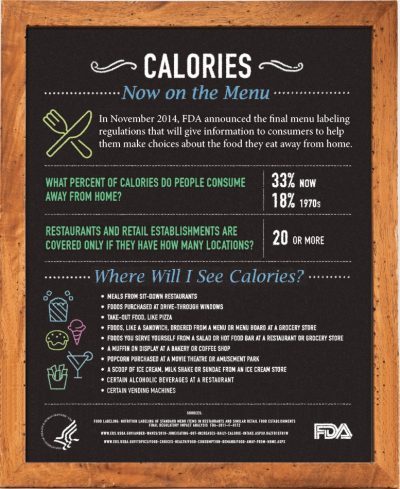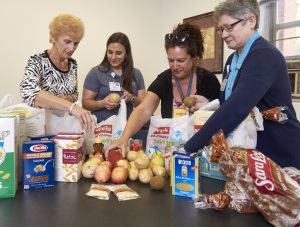 The FDA is delaying the public posting of calorie counts, a policy that President Obama’s administration had pioneered for public health and wellness. Menu labeling has applied to grocery stores, gas stations, convenience stores, movie theaters and sports stadiums that sell prepared food.
The FDA is delaying the public posting of calorie counts, a policy that President Obama’s administration had pioneered for public health and wellness. Menu labeling has applied to grocery stores, gas stations, convenience stores, movie theaters and sports stadiums that sell prepared food.
“Health and Human Services Secretary Tom Price said the menu labeling requirements would be ‘unwise and unhelpful’ as currently written, and added that the FDA is looking for ways to make the rules ‘more flexible and less burdensome.'”
Former FLOTUS Michelle Obama took on the issue of healthy food and fitness for America’s children. Except for keeping her White House healthy garden intact for the time being, it appears Mr. & Mrs. Obama’s health-and-wellness missions will be eliminated, based on this administration’s early actions, from President Trump’s policies. For example, Secretary of Agriculture Sonny Perdue rolled back Michelle Obama’s healthy school lunch program.
As a health economist, I have studied (and have come to appreciate) the evidence base for food in health, and some of my advisory work is focused on this intersection. If the Federal government won’t believe this evidence base, perhaps policymakers at the state level and in the private sector will.
One such example at the state level is Governor Tom Wolf in my home state of Pennsylvania. The Governor funds The William Penn Fellowships, supporting innovations at the Pennsylvania State level especially to inspire “Government That Works.” One area Governor Wolf ardently supports is public health. In that vein, I spoke with Amanda Cappelletti who is working on a William Penn Fellowship looking at child development, early childhood education, and nutrition.
I first asked about her research into food and early childhood development. “Food plays a critical role in early childhood development. To put it in perspective, the brain of a 4-5 year old uses twice as much glucose as an adult’s brain. A child’s body is 65% water, but her brain is 85% water. This means that for a pre-school aged child’s brain to properly develop the child needs to be properly nourished with whole fruits and vegetables, and hydrated. Studies have found a correlation between cognitive competence and nutrition in pre-school aged children, with malnourished children scoring significantly lower,” Amanda explained.
She pointed out that malnourished children aren’t only those “starving in poverty,” she coined. “In the U.S., malnourished children can be obese or of average weight. Malnourishment happens when children are not getting the vitamins and nutrients they need for healthy development. This is why it is critical to ensure that, from a young age, children are trying and eating whole fruits and vegetables of all kinds (and colors),” she added.
 I was particularly keen to hear about her take on farm-to-table programs for kids, “an excellent way introduce and incorporate whole fruits and vegetables into their diets,” Amanda noted. “Children’s, especially pre-school aged children’s, tastebuds are still developing. It will take at least ten times of them trying a food before truly knowing whether or not they like it. This can make feeding young children difficult, as many parents will tell you. Research has shown that young children that are involved in the food growing and preparation processes are more likely to try the foods with which they are working. Many farm-to-table programs allow the children to visit the farms, teachers will start their own little garden, and include the children in preparing foods to encourage the children to try different whole fruits and vegetables,” she explained.
I was particularly keen to hear about her take on farm-to-table programs for kids, “an excellent way introduce and incorporate whole fruits and vegetables into their diets,” Amanda noted. “Children’s, especially pre-school aged children’s, tastebuds are still developing. It will take at least ten times of them trying a food before truly knowing whether or not they like it. This can make feeding young children difficult, as many parents will tell you. Research has shown that young children that are involved in the food growing and preparation processes are more likely to try the foods with which they are working. Many farm-to-table programs allow the children to visit the farms, teachers will start their own little garden, and include the children in preparing foods to encourage the children to try different whole fruits and vegetables,” she explained.
I finally asked her how food policy can be better “baked” into public policy at the State level. She said, “Each state has what are known as Child Care Resource and Referral agencies (CCR&Rs) or Child Care Information Services (CCIS). These agencies serve different functions to assist both families and licensed facilities. Using this existing infrastructure, states can develop consortia of child care facilities to participate in farm-to-table/farm-to-preschool programs, using the CCR&Rs/CCISs as the administrators of the program. In Pennsylvania, for example, there are CCIS’s on an almost 1-to-1 ratio with the counties. The child care facilities in each county could come together with the CCIS of the county to participate in a farm-to-preschool program. By bringing together all of the child care facilities in one county, the program becomes cost-effective for both the farmers and the facilities. This not only improves the quality and variety of food being served at child care facilities, but it also helps each state’s economy.”
Health Populi’s Hot Points: In the private sector, we can also see examples of companies addressing food-health policy even without Federal government mandates. Seeing an opportunity to differentiate itself and do right by its shoppers, Wegmans announced the store would post calorie counts in the “grocerant” areas of the store, despite the lack of a government requirement to do so. [FYI, I’ve observed Wegmans’ ongoing role as a health destination in several Health Populi posts, among them this one on why a grocer believes in consumers’ health data. The grocer was also just found to score major loyalty among consumers in an annual survey by Market Force]. Wegmans, like other grocers, recognizes that consumers are increasingly looking to food as a determinant of health and wellness, as well as joining the food-as-medicine movement.
 On the hospital front, Geisinger Health System launched the Fresh Food Pharmacy to extend healthy food to people with diabetes in Shamokin, PA, via “food prescriptions” — de facto food-as-medicine. The program is supported by Weis Markets (a regional grocery chain) and the Degenstein Foundation, made available to people living with food insecurity – a major social determinant of health.
On the hospital front, Geisinger Health System launched the Fresh Food Pharmacy to extend healthy food to people with diabetes in Shamokin, PA, via “food prescriptions” — de facto food-as-medicine. The program is supported by Weis Markets (a regional grocery chain) and the Degenstein Foundation, made available to people living with food insecurity – a major social determinant of health.
The Fresh Food Pharmacy protocol was formed on evidence-based guidelines promulgated by the American Diabetes Association, which recommends fresh fruits and vegetables, lean proteins, and whole-grain foods to help people manage diabetes. Consuming fresh and nutrient-dense foods can reverse or slow diabetes progression.
Why Shamokin, PA? This is a part of the U.S. where over 20% of residents live below the poverty line, 12% of residents over the age of 20 have diabetes, and 1 in 3 people are food-insecure. Nearly 50% of Shamokin residents are predisposed to diabetes, mostly due to obesity– and well beyond national average.
 Food and beverage companies themselves have begun to take steps in leaning out, de-salting and de-sugaring foodstuffs, as well. To be sure, some of these actions may be to help stem Federal regulatory efforts as a defensive strategy. But there is evidence that many Big Food companies are moving in this direction; the Healthy Weight Commitment Foundation, for example, published new data summarizing the efforts of eleven food and beverage companies participating in the Commitment to Healthy Communities (CHC) program, investing over $30 million in community-based health and wellness initiatives in 2016. The data was vetted by the City University of New York School of Public Health (CUNY).
Food and beverage companies themselves have begun to take steps in leaning out, de-salting and de-sugaring foodstuffs, as well. To be sure, some of these actions may be to help stem Federal regulatory efforts as a defensive strategy. But there is evidence that many Big Food companies are moving in this direction; the Healthy Weight Commitment Foundation, for example, published new data summarizing the efforts of eleven food and beverage companies participating in the Commitment to Healthy Communities (CHC) program, investing over $30 million in community-based health and wellness initiatives in 2016. The data was vetted by the City University of New York School of Public Health (CUNY).
In my own community in suburban Philadelphia, I sit on the board of The Clinic, a free-to-all-comers primary care center. We take no government funding. People pay as they wish. Counseling and educating patients about the role of food in personal and family health is a mission of our physician Dr. Ana Negron, who practices food-as-medicine with patients as a natural workflow. Read more about this approach in today’s Philadelphia Inquirer newspaper in an article titled, Doctors writing fruit and vegetable prescriptions to battle hunger.
Notwithstanding even the most valiant nutrition+health efforts launched in the private sector, it’s the Federal government that must scale food+health efforts to all American health citizens. U.S. patients, now health consumers, will continue to pressure all touchpoints — public and private sector alike — for more nutrition baked into public policy. Grocery stores, hospitals, and food manufacturers are already responding to consumer demand.




 Interviewed live on BNN Bloomberg (Canada) on the market for GLP-1 drugs for weight loss and their impact on both the health care system and consumer goods and services -- notably, food, nutrition, retail health, gyms, and other sectors.
Interviewed live on BNN Bloomberg (Canada) on the market for GLP-1 drugs for weight loss and their impact on both the health care system and consumer goods and services -- notably, food, nutrition, retail health, gyms, and other sectors. Thank you, Feedspot, for
Thank you, Feedspot, for  As you may know, I have been splitting work- and living-time between the U.S. and the E.U., most recently living in and working from Brussels. In the month of September 2024, I'll be splitting time between London and other parts of the U.K., and Italy where I'll be working with clients on consumer health, self-care and home care focused on food-as-medicine, digital health, business and scenario planning for the future...
As you may know, I have been splitting work- and living-time between the U.S. and the E.U., most recently living in and working from Brussels. In the month of September 2024, I'll be splitting time between London and other parts of the U.K., and Italy where I'll be working with clients on consumer health, self-care and home care focused on food-as-medicine, digital health, business and scenario planning for the future...